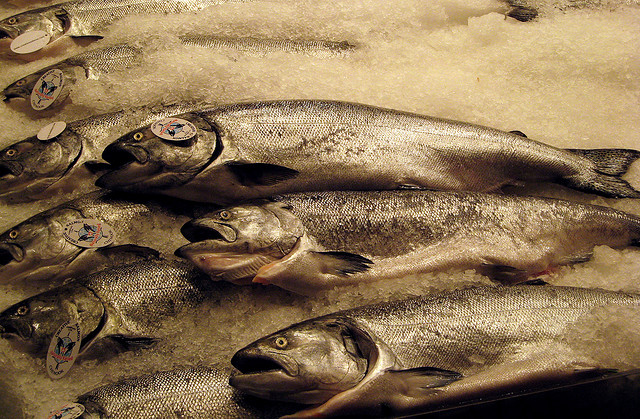What was the freshest fish you’ve ever eaten? I recall a salmon filet grilled with the scales still on, rich with its own juices, the barest tang of lemon and thyme transformed by a summer smoke. To eat something that is just barely dead, where you can still taste a hint of sea salt crusting the skin, is a world away from frozen supermarket tilapia and canned sardines. Good, fresh fish takes you back to the ocean.
New England is gifted enough to have a long and fruitful coast, so this delicacy isn’t far off. To support local fishermen, in fact, you can taste a little bit of summer by next week by purchasing a Cape Ann Fresh Catch share online.
What’s Cape Ann Fresh Catch? Think of a community supported agriculture program, but for local fishers instead of farmers. CAFC’s first catch of the season is on sale at Cambridge’s Morse School (and two other nearby locations) from 4 to 6 p.m. today – it’s pollock, according to the organization’s online calendar. The fish is local, as fresh as possible and – they say – sustainably caught.
For regular readers of Public Radio Kitchen, the name “Cape Anne Fresh Catch” might sound familiar. The community supported fishery previously got a skeptical treatment from us when Edible Boston’s Roz Cummins questioned their commitment to sustainability – last year’s shares were comprised of cod “almost every week during the summer,” she wrote. Cod is sometimes overfished and populations in the Gulf of Maine “are not yet recovered,” a spokeswoman from the New England Aquarium told Cummins.
Over the past year, however, Cape Ann Fresh Catch has made some improvements that may result in a more sustainable season. Turner’s Seafood – an independent processing plant in Gloucester – has joined on as a partner with CAFC to provide some tech updates to the program. Not only will Turner’s let members get their fishes filleted and skinned if they choose – before, you could only purchase the fish whole – they’re committed to buying a more varied species offering.
“Especially in New England, we have favorite species,” said Jim Turner, of Turner’s Seafood. “Haddock and cod happen to be two of the most famous, almost more favorite species. But we have other wonderful species that we catch here locally.”
Most of the time, Turner said, these catches get shipped to other parts of the country, due to low demand in New England. But with CAFC, Turner said he hopes that this can change.
“The theory is, if we can convince people and show people how great our other species here that are less well-known, that, in fact, will spread out the demand and lessen the demand on some of the more popular species,” Turner said.
These other species will include hake, ocean perch and flounders like grey sole, yellowtail and black back, Turner said – but still, cod and haddock will remain in CAFC offerings, something he ardently defends.
“There’s a lot of misinformation that gets put out there as far as what is sustainable and what is not,” he said. “We in New England are under as strict a fishery regulation as anybody […] We have a multitude of different regulations in place that we all follow that are designed to rebuild and make sure those stocks are sustainable. And what very few people understand and don’t realize is that we’ve been under these management plans for almost three decades now and there has not been one species that has not shown a tremendous increase.”
Species like cod sometimes have not met the government’s “imaginary line” of sustainability – “but that does not mean we’re not catching them in a sustainable format,” Turner said.
In the future, Turner hopes to be able to expand Cape Ann’s Fresh Catch distribution – he thinks people should be able to pick up their catch beyond regular distribution hours, for instance.
They want to offer more recipes and tips, too – Turner says his favorite way to eat fish is “pan-seared, with a little bit of flour, just so it gets a little crust on it.” Or, try Cummins’ way of preparing her cod: “Dressed with only butter and lemon juice, the taste was direct and clean. Uncomplicated is a good description, I suppose, but while it couldn’t have been simpler, it was also incredibly satisfying.” With fresh fish, after all, you don’t need much more.


I applaud you re-considering CAFC, it goes to the sustainability of eating and buying local. They heard your and others concerns and acted on them, something you don’t often see with the chain stores who are almost always concerned with sucking the dollars out of the consumers pockets to far off distant lands. The CAFC folks are local in the truest sense and the dollars they receive are vital to keeping them fishing viably. Nothing is perfect, but the ability to look the producer in the eye and thank, complain or ask them a question is priceless. That is something we all need now more than ever.
Pingback: Food Therapy from What’s Cooking in Your World? | Public Radio Kitchen